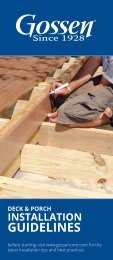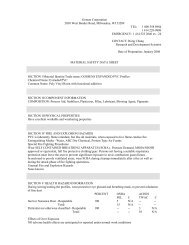Installation Guide - Gossen
Installation Guide - Gossen
Installation Guide - Gossen
You also want an ePaper? Increase the reach of your titles
YUMPU automatically turns print PDFs into web optimized ePapers that Google loves.
Expansion and Contraction<br />
When properly fastened to the substructure, Porch boards will have minimal contraction. Do not space at butt joints. Boards<br />
will not expand beyond their cut length or cause buckling. Fastening porch boards according to <strong>Gossen</strong> requirements will help<br />
minimize contraction.<br />
• Porch board must be installed at either a 90 degree or 45 degree angle to joists. (90 degree—do not exceed 16” on center joist<br />
spacing) (45 degree—Do not exceed 12” on center joist spacing)<br />
• Keep butt ends and miters tight.<br />
• All butt joints must be fastened to a solid joist. When using a pneumatic nailer, consider using a screw at the end of each<br />
board. Fasten within ½” of the end of the board.<br />
• For best results, stagger butt joints and miters across deck surface so that all butt joints and miters do not break on the same<br />
joist.<br />
• Install boards as soon after cutting as possible<br />
• Fasten each board within ½” from the end of board.<br />
• Minimum ¼” space around the deck post<br />
• Minimum ¼” space from any solid structure<br />
• Some area building codes may require double joisting when joining boards end to end.<br />
Always check with your local code authority for specific requirements before installation<br />
Perimeter Trim Suggestions<br />
There are many options available to finish the perimeter of the porch:<br />
• <strong>Gossen</strong> Rim Boards are solid color or contrasting white with a deep wood grain surface texture designed to compliment<br />
<strong>Gossen</strong> Porch Board<br />
• <strong>Gossen</strong> 5 ½” deck boards for perimeter strips. Porch Board colors match <strong>Gossen</strong> Deck Boards<br />
• <strong>Gossen</strong> exterior molding profiles<br />
Ventilation Requirements<br />
• Minimum joist height of 3½”<br />
• Must be adequately ventilated to ensure board temperature does not exceed 160 degrees<br />
• To prevent heat and moisture build-up, an unobstructed airflow is required below the porch (try adding flow-through vents at<br />
various locations around rim joists to increase airflow)<br />
Other Factors to Consider<br />
• Please be aware that excessive heat-build on the surface of <strong>Gossen</strong> products from external sources, such as, but not limited to,<br />
fire or reflected sunlight can potentially lead to damage. For example, sunlight that may be reflected by low-emissive (Low-E)<br />
glass can potentially lead to damage of exterior building products, including <strong>Gossen</strong> Porch board, Decking, or Railing products,<br />
due to elevation of surface temperatures, which far exceed that of normal exposure of the same materials to direct sunlight.<br />
Possible damage by such reflected concentrated light might include sagging, warping, distortion, increased contraction and<br />
unusual weathering. Porch board core temperature cannot exceed 160 degrees.<br />
• Cellular PVC Porch boards are more flexible than treated wood or composite boards. For greater rigidity, consider 12”-on-center<br />
joist spacing.<br />
• Do not allow construction dirt and debris to sit on the <strong>Gossen</strong> Porch surface. Remove dust, clay, dirt, mud, and other construction<br />
products from <strong>Gossen</strong> Porch immediately.<br />
• IMPORTANT: Do not allow dust from tile, concrete, landscape blocks, or any masonry product to accumulate on the Porch surface<br />
as it may damage the surface. Never cut any construction materials on or near the <strong>Gossen</strong> Porch.<br />
www.gossencorp.com 2




